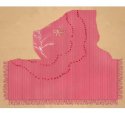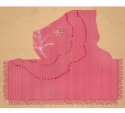https://news.google.com/newspapers?...AIBAJ&sjid=PdsFAAAAIBAJ&pg=2017,5762895&hl=en
This article says possible Spanish or Italian parentage.
This article says possible Spanish or Italian parentage.

Inside the suitcases, the police also found straw, dry packing foam, a cut up chenille bedspread and six sections of the New York Sunday News dated September 26, 1976. The bedspread was most likely originally pink in color, however, the worn and dirty condition made it appear more rust or coral colored. The bedspread had an embroidered yellow flower design.
By the 1930s clotheslines bearing chenille bedspreads lined U.S. Highway 41 through Dalton and other small communities in
Mrs. J. A. Green and her son, Allen Burton, make tufted bedspreads on U.S. Highway 41 in Bartow County, 1933. Green was one of the first in the county to make chenille bedspreads.
Chenille Bedspreads
northwest Georgia. Tourists on their way to Florida often stopped and bought these spreads, sometimes believing them to be examples of authentic American folk crafts. Of the many designs adorning the spreads, the most popular among tourists was the peacock. This section of Highway 41 became known as "Peacock Alley" precisely because of the dominance of that design in the roadside displays. The participation of farm families in this industry provided badly needed cash incomes and helped these families weather the Great Depression. It also produced fortunes for some. Dalton's B. J. Bandy (aided by his wife, Dicksie Bradley Bandy) was reputedly the first man to make $1 million in the bedspread business by the late 1930s, but many others followed.
In the 1930s such companies as Cabin Crafts began to bring the handwork from the farms into factories. The bedspread manufacturers sought greater productivity and control over the work process and were also encouraged to pursue centralized production by the wage and hour provisions of the National Recovery Administration's tufted bedspread code. These new firms also began mechanizing the industry by adapting sewing machines to the task of inserting raised yarn tufts.
The industrialization of tufting raised productivity and created a booming local textile industry centered in Dalton.
Exhibits related to the old bedspread industry can be found at Crown Gardens and Archives in Dalton. Crown houses a number of bedspreads from the period
rbbm
https://news.google.com/newspapers?...AIBAJ&sjid=PdsFAAAAIBAJ&pg=2017,5762895&hl=en
This article says possible Spanish or Italian parentage.
She and her baby are always on my mind. :rose:
I'm really starting to wonder if she was Turkish.
Did we ever have any luck chasing down the Candlewick bedspread she was found with?
I think it was chenille, not candlewick, wasn't it? I seem to recall that it wasn't anything special--the kind of thing common in spare bedrooms, hunting cabins, and cheap motels.
Inside the suitcases, the police also found straw, dry packing foam, a cut up chenille bedspread and six sections of the New York Sunday News dated September 26, 1976. The bedspread was most likely originally pink in color, however, the worn and dirty condition made it appear more rust or coral colored. The bedspread had an embroidered yellow flower design.
The phenomenon of chenille bedspreads in the early twentieth century evolved from the art of candlewicking. Candlewicking was a form of embroidery prevalent in the American colonies where the cotton thread that was used for the wicks in candles was also used to make designs on bedcovers. Generally, the candlewick thread would be left in its original white cotton state and stitched into a white cotton sheet. This type of embroidery died out by the mid nineteenth century.
Chenille bedspreads, as we came to know them in the twentieth century, were originally developed by a young lady from Dalton, Georgia named Catherine Evans. As a young girl in 1892, she visited a relative in McCuffy, GA who owned a vintage candlewicked spread. Upon her return home, Miss Evans sets out to create an imitation of the candlewicked spread she saw using the type of yarn available in her area at the time.
Catherine Evans continues to perfect her craft, hand-tufting each spread. She gave one to her sister-in-law as a wedding gift and it made quite a splash on family and friends. Through word of mouth, Miss Evans began selling her hand tufted spreads at $2.50 apiece.
At this point it is worth noting how this form of tufting came to be called chenille. Chenille is the French word for caterpillar. Very often the tufts in a chenille bedspread are cut from the top to give them that fuzzy look and feeling like a caterpillar. Not all chenille bedspreads are cut loop like this though. The non-cut loop spreads are often referred to as needle-tuft which more closely resemble candlewicking. Nonetheless, the name chenille (caterpillar) stuck for posterity.
From the one with the bumps to the towel-like weave, weve heard them all it when it comes to folks describing the Bates Terry Collection. Were happy to take this opportunity to share the many terms there are in the textile world to describe this very special weave. We choose to use Terry as our foremost descriptor, but the terms candlewick or popcorn chenille also describe the same weave. Please note that Ill use them interchangeably in the description below.
A bedspread featured in our Terry Collection is characterized by the loops that are pulled upward from the fabric weave that create the featured pattern. If you were to run your hand across a candlewick bedspread you would feel the soft loops. This type of weave is a good insulator by the nature of its construction so its perfect for woven products like bedspreads.
Please refer to the photos below to see the difference between between our matelassé and candlewick bedspreads:
CANDLEWICK: Fabric woven on jacquard looms to create fluffy tufts of soft cotton yarns closely arranged in continuous lines or spaced at intervals to create a design. Often called chenille (which is a type of very soft yarn), the name candlewick refers to fabric loops as being similar in length to the wick of a candle. Our candlewick designs are made of terry loop fabric.
CHENILLE: A very soft yarn used as filling in fabrics with a fuzzy appearance.


Just want to say that on her NamUs profile , there is a lot missing such as clothing and accessories, it's checked no clothing or accessories. Then when you click on the photos of the luggage and bedspread, it doesn't list the description. Wish I had time to get the info together to give to Amy Dobbs.
Very strange how it was cut like that, I never realized it had been cut. Wonder why it was cut?
I must have looked at that photo dozens of times and I never really registered how odd the shape was. It looks to me like somebody cut pattern pieces out of it.
Huh. I've never heard candlewick used to refer to anything but hand embroidery with candlewicking thread. It's usually a pattern of French knots. It's still practiced as a needle art (I've done it myself). It's usually done unbleached thread on unbleached muslin or bleached cotton (like flour bag cotton), but modern projects often use colors. (Photo from wikihow.com).
But it sounds like calling it a candlewick bedspread is not incorrect. I always assumed the design was off center due to it being cut up.
View attachment 99542
There was no clothing or accessories.
http://www.pamissing.com/bethdoe.html
The three suitcases the remains were found in were all the same size (23" x 14" x 7 1/2"). Two of them were blue in color, one was blue and tan plaid. The handles had been cut off of the suitcases before they were dropped at the site and the zippers had been painted with flat black paint.
Inside the suitcases, the police also found straw, dry packing foam, a cut up chenille bedspread and six sections of the New York Sunday News dated September 26, 1976. The bedspread was most likely originally pink in color, however, the worn and dirty condition made it appear more rust or coral colored. The bedspread had an embroidered yellow flower design.
I must have looked at that photo dozens of times and I never really registered how odd the shape was. It looks to me like somebody cut pattern pieces out of it.
We use essential cookies to make this site work, and optional cookies to enhance your experience.
